
The Suzuki SV650 and its variants are street motorcycles manufactured since 1999 by Suzuki. In 2009, Suzuki replaced the standard SV650 with the SFV650 Gladius. In 2016, the Gladius name was discontinued and the 2017 model was reverted to SV650.

The Kawasaki Ninja 250R is a motorcycle in the Ninja sport bike series from the Japanese manufacturer Kawasaki originally introduced in 1986. As the marque's entry-level sport bike, the motorcycle has undergone few changes throughout its quarter-century lifetime, having received only three substantial redesigns. In some markets the Ninja 250R has been succeeded by the Ninja 300.
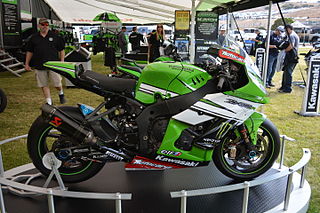
The Kawasaki Ninja ZX-10R is a motorcycle in the Ninja sport bike series from the Japanese manufacturer Kawasaki, the successor to the Ninja ZX-9R. It was originally released in 2004 and has been updated and revised throughout the years. It combines an ultra-narrow chassis, low weight, and radial brakes. In 2004 and 2005 the ZX-10R won Best Superbike from Cycle World magazine, and the international Masterbike competition.

The Vulcan name has been used by Kawasaki for their custom or touring bike since 1984, model designation VN, using mostly V-twin engines ranging from 125 to 2,053 cc.
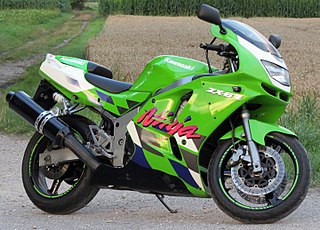
The Kawasaki Ninja ZX-6R is a 636 cc class motorcycle in the Ninja sport bike series from the Japanese manufacturer Kawasaki. It was introduced in 1995, and has been constantly updated throughout the years in response to new products from Honda, Suzuki, and Yamaha. The ZX series is what was known as the Ninja line of Kawasaki motorcycles in the 1980s and still carries the name today.

The Suzuki Bandit is a series of standard motorcycles produced by Suzuki since 1989. The Bandit series includes the following models:
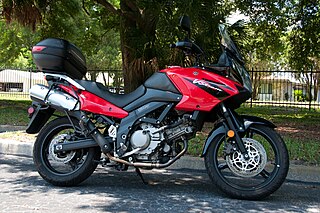
The Suzuki V-Strom 650 (DL650) is a mid-weight, sport touring motorcycle made by Suzuki since 2004, in its third generation since model year 2017. It has a standard riding posture, fuel injection and an aluminum chassis. Marketed in Europe, Oceania, the Americas, and since 2018, India, the DL650 is manufactured at Suzuki's final assembly plant in Toyokawa, Japan. The V-Strom 650 trades strength in a single area for adaptability to a variety of riding conditions: commuting, cruising, adventure touring, and to a lesser degree, off-road riding. The bike is variously categorized as dual sport, sport enduro tourer, street/adventure, commuter, or entry-level.

The Yamaha FJR1300A and FJR1300AE/AS are sport touring motorcycles made by Yamaha Motor Company. Both models have a 1,298 cc inline-four engine. The AE/AS model has an electronically controlled clutch and gear shifting system called YCC-S. The clutch and transmissions of the AE/AS models are identical to that of the standard FJR model.
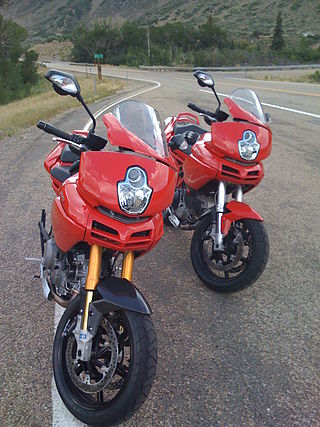
First introduced in 2003, the Ducati Multistrada is a series of V-twin and V4 touring focused motorcycles. Essentially a hybrid of a supermoto and a sport-tourer, the Multistrada competes in the market with other dual-sport motorcycles such as the BMW GS. The first iteration of the Multistrada was, like the Yamaha TDM850, neither intended nor suitable for off-road use. Subsequent models were more suited to a proper dual-sport role.

The Honda CBR600RR is a 599 cc (36.6 cu in) sport bike made by Honda since 2003, part of the CBR series. The CBR600RR was marketed as Honda's top-of-the-line middleweight sport bike, succeeding the 2002 Supersport World Champion 2001–2006 CBR600F4i, which was then repositioned as the tamer, more street-oriented sport bike behind the technically more advanced and uncompromising race-replica CBR600RR. It carried the Supersport World Championship winning streak into 2003, and on through 2008, and won in 2010 and 2014.

The Suzuki GSX-R750 is a sports motorcycle made by Suzuki since 1984. It was introduced at the Cologne Motorcycle Show in October 1984 as a motorcycle of the GSX-R series for the 1985 model year.

The Suzuki GS500 is an entry level motorcycle manufactured and marketed by the Suzuki Motor Corporation. Suzuki produced the GS500 and GS500E from 1989 on and the fully faired model, GS500F from 2004 on. The GS500 is currently being produced and sold in South America. The GS500 has been described in the motorcycle literature as a best buy and an excellent first bike, with adequate if not exciting power for more experienced riders.
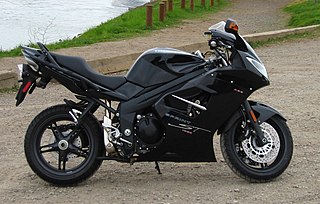
The Triumph Sprint ST is a sport touring motorcycle manufactured in the United Kingdom by Triumph between 1999 and 2010. Sporting a 1050cc 4-stroke three-cylinder engine, an alloy-beam frame and a single-sided swingarm, the Sprint ST competed effectively in the market against the Honda VFR800. In 2010 the Sprint ST was succeeded by the Triumph Sprint GT.

The Kawasaki 1400GTR, also known as the Concours 14 or ZG1400 in some markets, is a sport touring motorcycle produced by Kawasaki. The 1400GTR was introduced in September 2007 and is based on the ZX-14 platform. It replaces the original GTR1000 (Concours), which was built from 1986 to 2006.

The Aprilia Tuono is a naked motorcycle manufactured by Aprilia from 2002. It is based on the Aprilia RSV Mille. Its successor, the Aprilia RSV1000R superbike shares its engine, gearbox, frame and, partly, its suspension. The Tuono was succeeded by the Aprilia Tuono V4 R for model year 2011, though the V2 model continued in production into the 2011 model year.

The Ducati ST series is a set of Italian sport touring motorcycles manufactured by Ducati from 1997 through 2007. In order of release, the series comprised five distinct models: the ST2, ST4, ST4S, ST3, and ST3S. Intended to compete with other sport-tourers such as the Honda VFR, the ST Ducatis had a full fairing, a large dual seat and a relaxed riding position for both rider and pillion. The ST bikes had a centre-stand, and could be fitted with optional matching luggage.
The Honda CB900F is a Honda motorcycle made in two iterations which appeared some twenty years apart. Both generations of the CB900F are straight four-cylinder four-stroke 900 cc (55 cu in) roadsters.

The Kawasaki Ninja 1000 SX is a motorcycle in the Ninja series from the Japanese manufacturer Kawasaki sold since 2011. Other than its name, it is unrelated to the Ninja 1000R produced from 1986–89, or to other Ninja motorcycles.

The Kawasaki Ninja 400 is a 399 cc Ninja series sport bike introduced by Kawasaki in 2018 originally. It was then recreated as a successor to the Ninja 300. It launched with the 2018 model year.

The Kawasaki Versys-X 300 is a member of the Versys range and has been manufactured since 2017 with yearly revisions. A 250cc version of this motorcycle is also available in four countries.



















